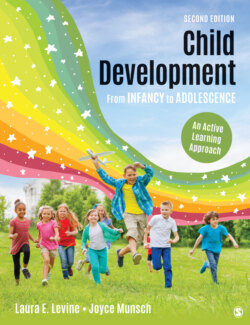Читать книгу Child Development From Infancy to Adolescence - Laura E. Levine - Страница 145
На сайте Литреса книга снята с продажи.
Self-Report Measures
ОглавлениеAnother way to gather information relatively quickly and efficiently is to use self-report measures such as surveys, questionnaires, and interviews. However, the usefulness of the data from self-report measures largely depends on the accuracy and validity of the responses received, so having questions that are precise, well written, and understandable is essential.
Survey: A data collection technique that asks respondents to answer a predetermined set of questions.
Questionnaire: A written form of a survey.
Interview: A data collection technique in which an interviewer poses questions to a respondent.
One problem with self-report measure is that the person answering the questions may be unwilling or unable to give complete or accurate responses. And sometimes respondents give the answer they think the researcher is looking for, or one they think makes them look good in the researcher’s eyes, a problem called social desirability. You can see how social desirability becomes a challenge for researchers investigating sensitive topics such as sexuality, drugs, or prejudice. The Journey of Research: Children’s Eyewitness Testimony illustrates the powerful influence the wording of questions can have on the data we obtain.
Social desirability: The tendency of respondents to answer questions in a way to please the researcher or to make them look good in the researcher’s eyes.
Journey of Research: Children’s Eyewitness Testimony
A revealing illustration of the impact of how we ask a question on the answer we get comes from research on children’s eyewitness testimony. In the 1990s, there were several high-profile cases of alleged child abuse. Under relentless and often suggestive questioning, children described horrific abuse at the hands of adults who were caring for them. Based on this testimony, a number of defendants initially received jail sentences, but in all these cases the charges were later dismissed or the plaintiffs were released from prison because of the improper way evidence had been gathered.
In the notorious McMartin Preschool case, seven teachers were accused of sexually abusing several hundred young children based on interviews such as this one:
Interviewer: Can you remember the naked pictures?
Child: (Shakes head “no”)
Interviewer: Can’t remember that part?
Child: (Shakes head “no”)
Interviewer: Why don’t you think about that for a while, okay? Your memory might come back to you.
We now know that even young children are able to accurately recall events and can give reliable eyewitness testimony (Odegard & Toglia, 2013), but when questions are misleading, the children are subjected to repeated questioning, or the interviewer makes overt suggestions about what has happened, we cannot trust children’s answers (Krähenbühl & Blades, 2006). It is clear from the way the interviewer in the McMartin case kept repeating the question and refused to accept the child’s denial that there had been naked pictures that this interviewer had a particular answer in mind and wanted the child to give that answer. The questioning is not at all unbiased. Suggesting that a memory “might come back” implies that the event is something that happened but has been forgotten rather than allowing the possibility that it never happened at all. Because children are limited in their ability to understand and interpret language, we need to be particularly careful about the wording of questions when designing surveys, questionnaires, and interviews for them. In Chapter 11 you will read about best practices for conducting a forensic interview of possible victims of child abuse (Newlin et al., 2015). Using these techniques, the interviewer can help the child talk about his or her experiences without inadvertently suggesting answers to the interviewer’s questions.
Source: Interview Number 111, p. 29 as cited in Garven, Wood, Malpass, & Shaw (1998, p. 349).
Usually interviewers ask everyone in the sample the same set of questions, but sometimes they want to ask additional follow-up questions or ask the respondent to expand on the original answers or provide examples. In this case, researchers can use a clinical interview, which allows this greater flexibility. Much of Piaget’s research was based on clinical interviews.
Clinical interview: An interview strategy in which the interviewer can deviate from a standard set of questions to gather additional information.
Because infants and children may be too young to respond to an interviewer’s questions, we may need to rely on information provided by a second party, such as parents, childcare providers, and teachers. The more time these people have spent with the child and the more familiar they are with the child’s behavior, the more likely they will be able to provide high-quality information. Parent reports have been used to describe the challenges faced by their children with cerebral palsy (Forsman & Eliasson, 2016), and teacher reports of bullying of overweight children in the school environment (Jansen et al., 2014).
